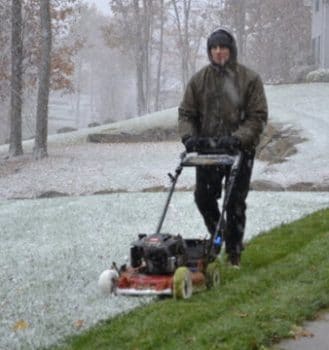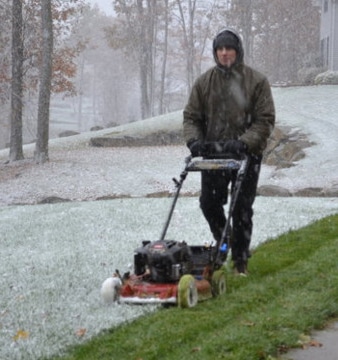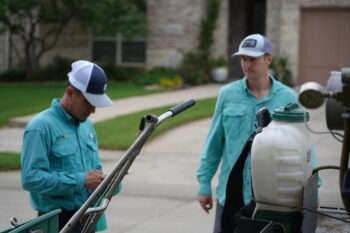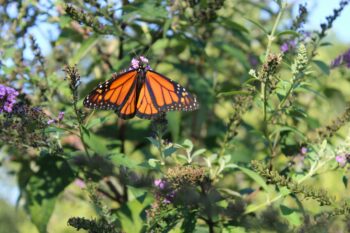 The recent freeze our state endured generated a level of weather-related destruction we rarely see here in North Texas. With the power outages, limited water supply, and basic needs barely being met, most of us were left reeling when the storm had finally passed.
The recent freeze our state endured generated a level of weather-related destruction we rarely see here in North Texas. With the power outages, limited water supply, and basic needs barely being met, most of us were left reeling when the storm had finally passed.
As we all began to survey the various types and level of damage, many homeowners have been left to wonder whether their yards and gardens will be able to bounce back after such a lengthy freeze. Fortunately, our Tree and Shrub Trimming, Fertilization, and Insect service programs can help you get your ailing lawn back up to par.
Here are a few things you can give some extra attention to in the meantime, to give your lawn and garden the best chance for recovery.
Irrigation
It is absolutely critical to water your lawn once the ground and grass have both thawed. In an effort to prevent frostbite, plants tend to push stored moisture to the very outer-most parts of their foliage.
Doing so prevents them from completely freezing, but it also puts them at risk for a rapid path to dehydration. Why? Because the foliage has intentionally deprived itself of an otherwise normal level of hydration in its attempt to avoid freezing.
So what do we do? We WATER our lawns, shrubs, gardens, and trees once the freeze has passed. If we do our part to counteract the damage of the recent frost, we give our landscape the pest possible chance to recover.
Pruning
While pruning and trimming are not typically necessary during the darkest and coldest months of the year, recovering from a hard freeze creates an exception. Whether it is grass, flowers, shrubs, vines, or trees- the plant’s natural instinct is simply to stay alive.
Given that, one can easily see how wasteful it can be to continue sending water and nutrients to the plant’s outermost extremities in a faltering attempt to salvage the dying tissue. This is where you come in with a plan to prune, on behalf of your ailing plants.
Freeze or no freeze, the foremost purpose of pruning is to remove parts of the plant that are no longer thriving. This allows the organism to put its resources toward areas of healthy, thriving growth.
Our active growing season is approaching quickly here in North Texas. After all, Spring is less than a month away! The best thing you can do for every living thing in your landscape is to help it “cut the losses” – quite literally, so all available resources are directed toward healthy growth from root to tip.
Most winter freezes in North Texas are not nearly as severe as what we faced in 2021. For more information regarding common seasonal lawn care issues, check out Seasonal Lawn Care From Winter to Spring.
There is, however, one caveat when it comes to post-frost pruning. With many plants, there may be some slight discoloration along the edges of its foliage. That doesn’t mean the tissue is no longer viable; it simply means you should monitor it in the coming days and weeks, to determine whether it is capable of a robust recovery.
Herbicides
Applying a pre-emergent herbicide is always a good plan for encouraging robust growth as spring arrives. And in the aftermath of a prolonged frost, it is doubly important to take this precaution.
As discussed in previous articles about pre-emergent application, there is a variety of weeds that overwinter successfully, thereby giving you an unwelcome surprise when spring comes around. No homeowner want to be met with the unwelcome presence of intrusive plants they did not invite into their yard.
Compromised gardens and grass beds are all the more vulnerable to the spread of opportunistic weeds. For this reason, you want to be sure and treat your lawn with preventative products in order to stay ahead of the game with weed control. PRE-EMERGENT! Many weeds begin to take over within the soil before your turf comes out of dormancy. Damaged turf is all the more susceptible to invasion. Pre-emergents can keep you a step ahead, esp after a hard freeze.
Mulching
A hard freeze, especially a lengthy one, is unfortunately a very effective way for your lawn and topsoil to lose valuable nutrients and minerals. Freezing weather and subsequent thaw can easily kill or wash away vital elements from your topsoil.
Mulch can be made from any manner of organic material, and spread throughout your lawn, garden, and shrub hedges. A hard freeze can deplete your landscape’s nutrients either by killing beneficial microbes or by washing away vital nutrients as the ice and snow melt.
Best practice is to maintain and spread any organic material available to you, and disperse it throughout your lawn and garden. This includes lawn clippings, fallen leaves and twigs, and even leftover produce from your kitchen that can be broken down and dispersed.
Final Thoughts
Recovering from a hard freeze, even a lengthy one such as what we endured in February of 2021, does not have to be a daunting or overcomplicated tasks. There are multiple simple steps you can take to fortify your lawn. And if you would rather leave the work to the professionals, Ryno Lawn Care is always here to assist you.





